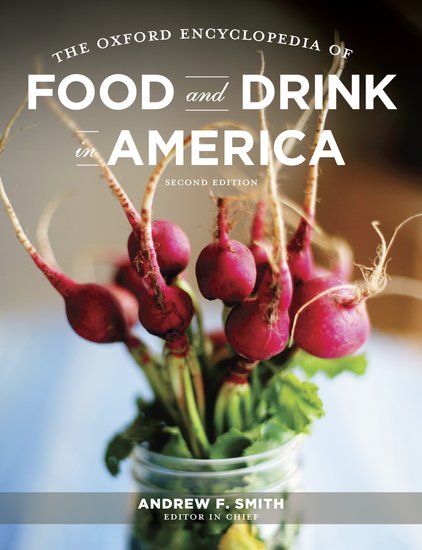November is National Pomegranate Month and we thought it’d be interesting to highlight the fascinating history of this fruit. Here are some fun facts from The Oxford Encyclopedia of Food and Drink in America, Second Edition, edited by Andrew F. Smith. Plus, the “Pomegranates” entry in the Encyclopedia by David Karp.
 (1) In Lebanon, a sweet syrup made from pressed pomegranate seeds is utilized in making Mouttabal, otherwise known as Baba Ghanoush.
(1) In Lebanon, a sweet syrup made from pressed pomegranate seeds is utilized in making Mouttabal, otherwise known as Baba Ghanoush.
(2) Ancient Hebrews revered pomegranates as one of seven special species along with wheat, grapes, figs, barley, olives, and date honey.
(3) Chinese New Year (Xinnian) is a lunar festival on the Chinese lunar calendar, falling between January’s end and early February. It begins with a feast on New Year’s Eve; children and elders gather to see the old year out and eat Buddha’s Delight, a dish of eight vegetables wishing for a lucky year. During this time, in some parts of China other symbolic foods fill the table including pomegranates, their seeds a wish for many children.
(4) Pomegranates are considered a subtropical fruit along with citrus fruits, such as grapefruit, lemon, lime, mandarin, and orange, and others, such as avocado, cactus fruit, date, fig, kiwifruit, mulberry, olive, and persimmon.
(5) Since most edible fruits have the potential to ferment without human intervention, wine-like fruit beverages have a global history dating back to humanity’s earliest origins. Ancient Egyptian pomegranate wines and Mesopotamian date wines are among the earliest documented examples.
(6) Functional foods, also known as “designer foods,” are not pills or elixirs. They are similar in appearance and usage to conventional foods — cereal products, dairy products, confectionery, prepared meals — but go beyond the nutrition and satisfying hunger purposes to also provide medical benefits to the body and mind. Pomegranate juice, for instance, is inherently functional with science-backed evidence of benefits for urinary tract infection.
(7) Old World fruits thrived in the American colonies. The colonists established orchards at an early date, and within twenty years of initial settlements, orchards were in full production in all colonies. Depending on climatic conditions and the region, colonists grew pomegranates, apples, cherries, currants, peaches, pears, plums, and quinces. Pomegranates, along with figs, nectarines, and oranges, grew on the coastal plain from South Carolina to Florida.
Pomegranates
The pomegranate (Punica granatum) originated somewhere in the region from Central Asia to Turkey, most likely in Iran, where it has been cultivated for five thousand years. Regally beautiful in its scarlet, leathery skin and turreted crown, it is like a treasure chest inside, with papery white membranes encasing hundreds of glistening garnet gems — seeds embedded in juice sacs. The flavor is sweet-tart and winy, intense but refreshing.
The pomegranate was introduced into Florida by the Spanish no later than the sixteenth century. Almost all of the American crop now comes from the San Joaquin Valley of California, where hot, dry summers mature sweet, attractive fruit. The main commercial variety is the modestly named Wonderful, propagated in 1896 from a Florida cutting. Since the 1990s plantings in California have increased eightfold to 24,500, as the fruit has enjoyed a vogue for its perceived health benefits. The season for fresh fruit runs from August through December, peaking in October and November. Pomegranates are used for decoration, eaten fresh (a rather messy affair), and juiced; the juice is used for making jelly, sorbet, cool drinks similar to lemonade, and a kind of wine.
bibliography
Hodgson, Robert W. The Pomegranate. Berkeley: University of California Press, 1917.
Levin, Gregory. Pomegranate Roads: A Soviet Botanist’s Exile from Eden. Forestville, Calif.: Floreant Press, 2006.
Seeram, Navinda P., Risa N. Schulman, and David Heber, eds. Pomegranates: Ancient Roots to Modern Medicine. Boca Raton, Fla.: CRC Press, 2006.
The second edition of The Oxford Encyclopedia of Food and Drink in America thoroughly updates the original, award-winning title, while capturing the shifting American perspective on food and ensuring that this title is the most authoritative, current reference work on American cuisine. Editor Andrew F. Smith teaches culinary history and professional food writing at The New School University in Manhattan. He serves as a consultant to several food television productions (airing on the History Channel and the Food Network), and is the General Editor for the University of Illinois Press’ Food Series. He has written several books on food, including The Tomato in America, Pure Ketchup, and Popped Culture: A Social History of Popcorn in America. The Oxford Encyclopedia of Food and Drink is also available on Oxford Reference.
Subscribe to the OUPblog via email or RSS.
Subscribe to only food and drink articles on the OUPblog via email or RSS.
View more about this book on the ![]()
![]()
Image credit: Pomegranate tree in fruit. American Colony (Jerusalem). Photo Dept., photographer. [between 1925 and 1946, from a negative taken approximately 1900 to 1920]. Library of Congress Prints and Photographs Division.


Recent Comments
There are currently no comments.